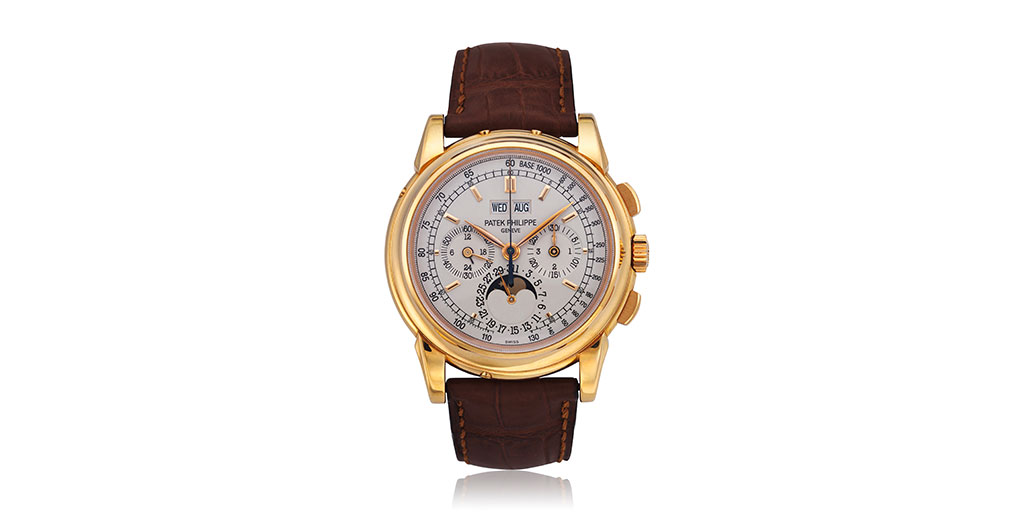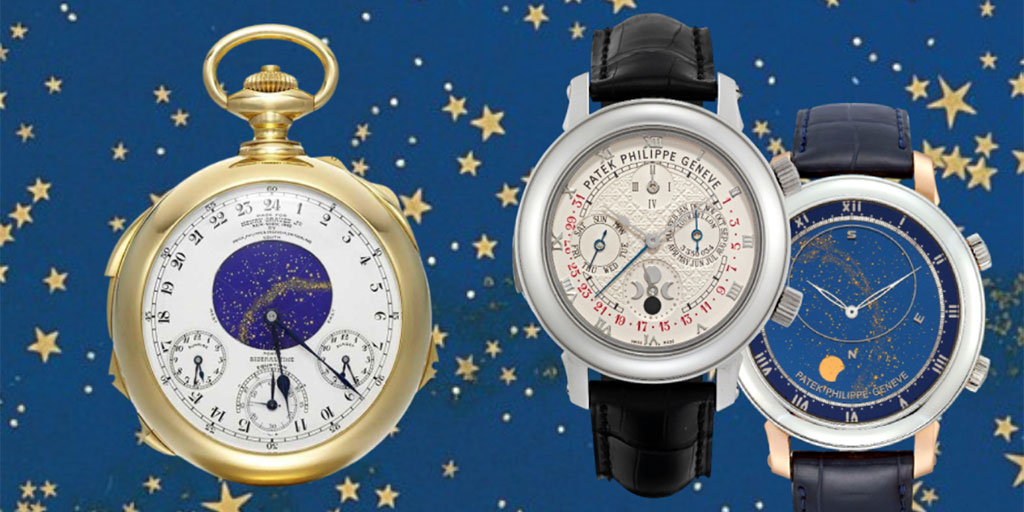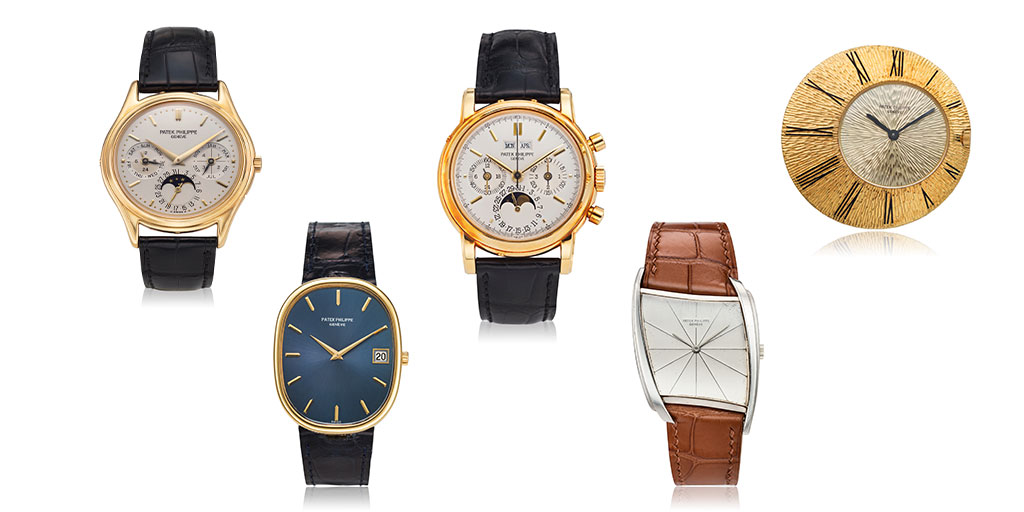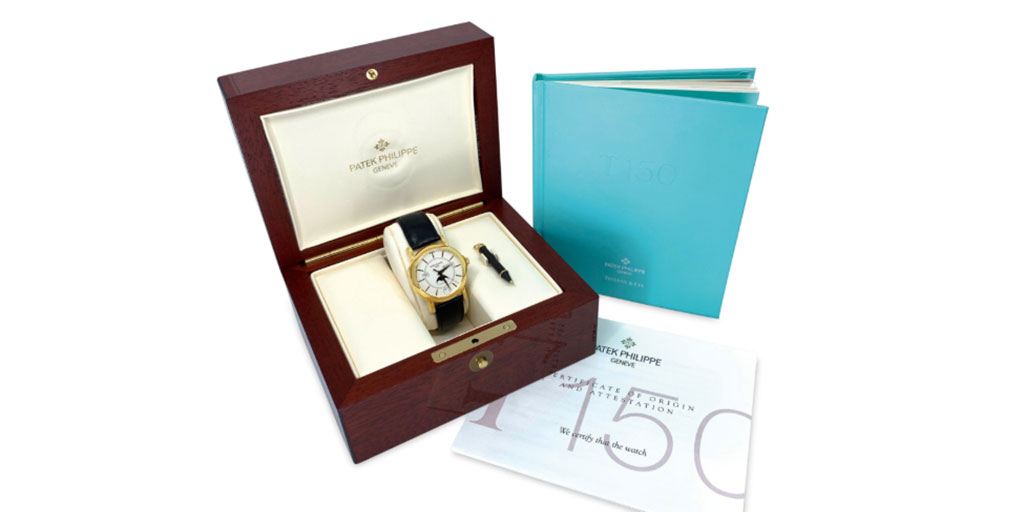More than twenty years have passed since Patek Philippe unveiled ref. 5970, which many collectors consider one of the most significant perpetual calendar chronographs ever produced. With only six years of official production from 2004 to 2010, it represents a crucial transition in Patek Philippe’s flagship complication—the last to use a third-party Lemania movement and the shortest run of any perpetual calendar chronographs.
The ref. 5970 was Thierry Stern’s answer to his father’s challenge: create a modern successor to the beloved ref. 3970. The result was a 40mm case that struck the right balance between contemporary wearability and classical inspiration. Its design pays clear homage to the lineage that began with the ref. 1518 in 1941, while introducing elements that clearly makes it in the 21st century watch.
This guide examines every aspect of the ref. 5970—from its distinctive case and dial design to production numbers, special editions, and current market dynamics. Whether you’re considering your first perpetual calendar chronograph or looking to understand why this particular reference holds such significance among collectors, the following article provides the comprehensive overview needed to appreciate this important chapter in Patek Philippe’s history.
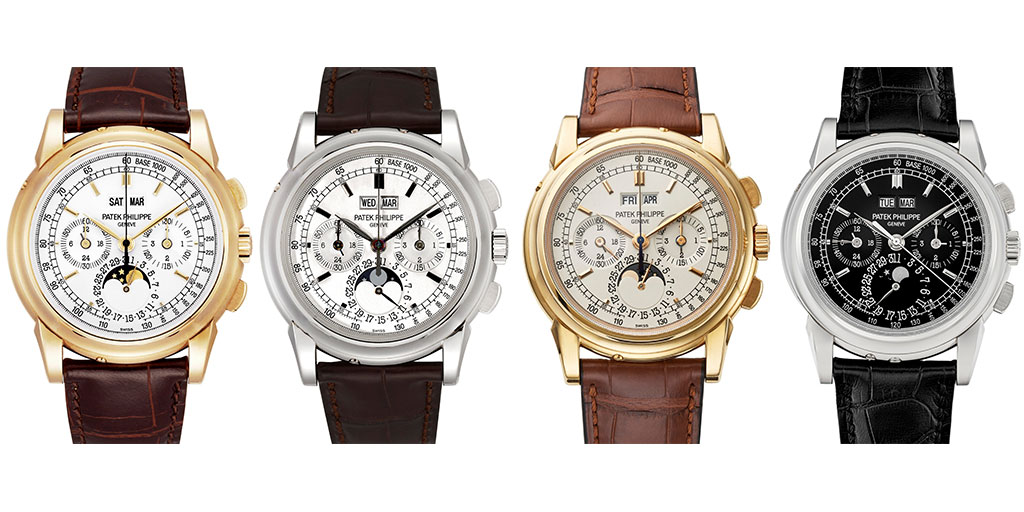
The Flagship Complication
The perpetual calendar chronograph stands as Patek Philippe’s most prestigious complication, representing nearly eight decades of continuous development across five generations. This complex combination of functions has defined the brand’s position in haute horlogerie since its introduction and remains central to its identity today.
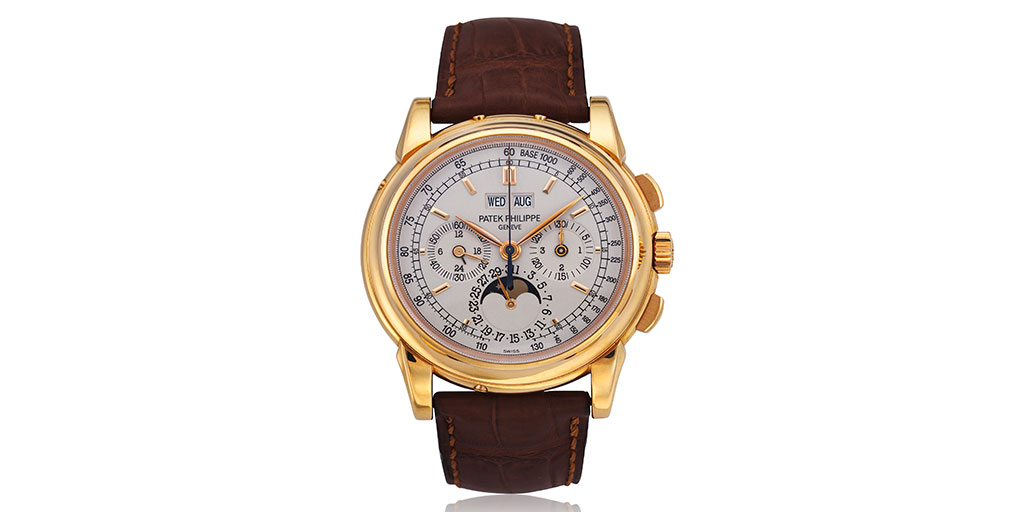
The lineage begins with ref. 1518, launched in 1941 as the world’s first serially produced perpetual calendar chronograph wristwatch. Patek Philippe held a monopoly on this complication for decades, establishing its reputation. It was succeeded in 1951 by the legendary ref. 2499, which like its predecessor featured a Valjoux movement and was produced across four series over thirty-four years. Many collectors consider the ref. 2499 the quintessential Patek Philippe, and it commands cult status among collectors.
Ref. 3970 was introduced in 1986 at the height of the quartz crisis, updating the complication for the modern era with a 36mm case and a Lemania based movement. An interesting deviation occurred in 1994 with the ref. 5020, featuring a distinctive cushion-shaped case. The ref. 3970’s direct successor, the ref. 5970, debuted at Baselworld 2004. While retaining the same Lemania-based movement as its predecessor, the ref. 5970 introduced a contemporary 40mm case that better suited modern preferences.
The ref. 5970’s mere six-year production run concluded in 2010 when Patek Philippe introduced ref. 5270, their first entirely in-house perpetual calendar chronograph, which has been in production to this day.
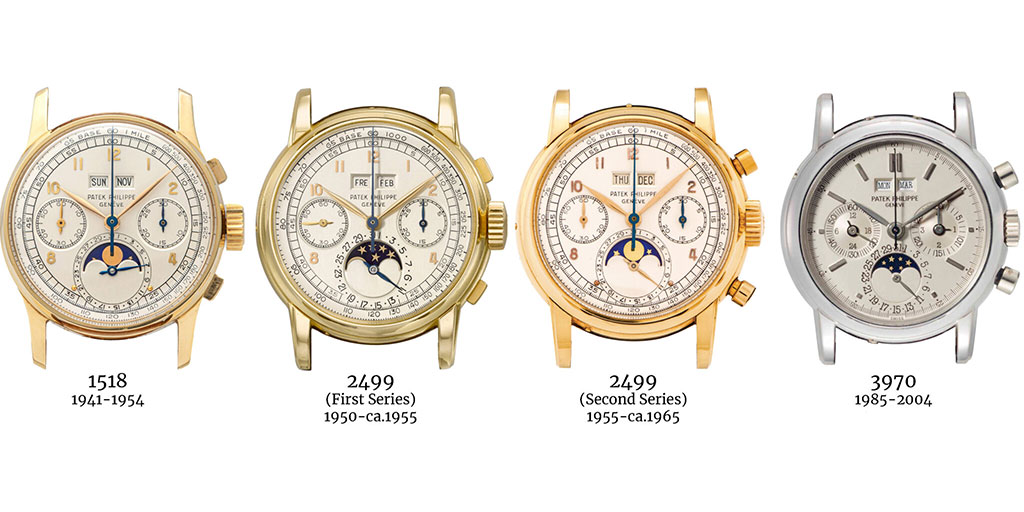
The Case
The case design is both rooted in tradition and distinctly modern. Its most obvious feature is the 40mm size, which is a significant increase of 4mm compared to the ref. 3970. While the early 2000s trend was toward larger and larger cases, 40mm wasn’t considered particularly imposing. Since it maintains the same 12.9mm height as the ref. 3970 (described by some as “bubbly”), the overall proportions strike a sweet spot.
The concave bezel and rounded central case band echo the ref. 3970. However, the square pushers and recessed crown area clearly reference the Vichet-cased first-series ref. 2499. The pushers give it a slightly sportier, more youthful aesthetic while maintaining full chronograph functionality.
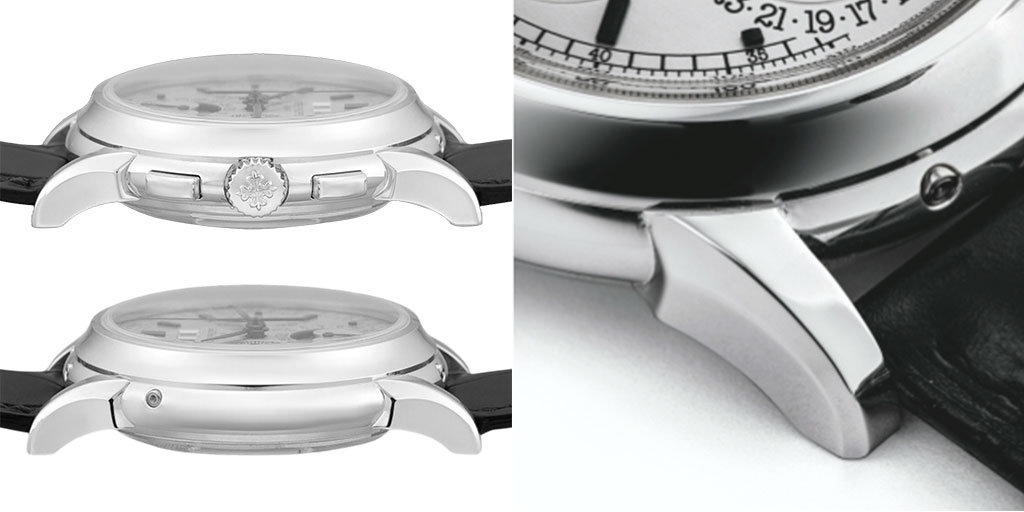
The unique lug’s shape particularly stands out. They appear both robust and refined, though they are notably difficult to polish. Again, this design references the first-series ref. 2499 with the slightly flared and stepped lugs. It incorporates elements reminiscent of spider lugs (like those on the ref. 1578) with hints of the flame lugs found on the ref. 2431.
The watches were delivered with a sapphire case back and included a second, solid case back, though most owners chose not to use it. Maker’s marks and precious metal hallmarks are stamped beneath each lug.
During its six-year production run, watches were made in rose gold (ref. 5970R), white gold (ref. 5970G), yellow gold (ref. 5970J), and platinum (ref. 5970P). No pieces are known in other metals.
On the wrist, the watch demonstrates excellent wearability: the larger 40mm case is very well balanced and thanks to lugs that extend naturally from the case, making it comfortable for most wrist sizes and has a great presence.
The Dial
Creating an exceptional dial design is notoriously difficult, with every detail needing to be carefully considered. Here again, the ref. 5970 excels. Initially, one might struggle to articulate exactly what makes the dial feel so special – it’s the sum of individual details that creates such an outstanding result. Reportedly, over 20 designs were tested before settling on the final version.
The dial’s symmetry is immediately striking: horizontally with the sub-registers placed exactly at 3 and 9 o’clock and vertically with the apertures at 12 o’clock and moon phase at 6 o’clock. This creates an immediate impression of harmony, balance, and legibility that’s remarkably difficult to achieve.
Here is the detail of each of the functions:
- Center: hour, minute, chronograph seconds
- 12 o’clock: day of the week & month
- 3 o’clock: 30 min chronograph counter & leap year
- 6 o’clock: moon phase & day
- 9 o’clock: small seconds & 24h day/night indication
Since the ref. 5970 shares the same Lemania movement as the ref. 3970, the functions are placed exactly at the same place. However, since the ref. 5970 is 4mm larger, this creates considerable negative space around the central display. This space was cleverly utilized to incorporate a tachymeter scale, reminiscent of first- and second-series ref. 2499s, which acts as a frame around the central indications. A tachymeter scale is used to calculate the average speed over a distance of a kilometer (km/h) or a mile (mph). Applied faced indices mark the hours at 12 (long, double), 1/2/4/8/10/11 (long, single) and 3/5/7/9 (square dot).
To improve legibility, the date indication was enlarged compared to the ref. 3970. Since the date would conflict with tachymeter markings between 130 and 110, the tachymeter has been removed on all gold versions. Only the final platinum version features the 120 marking, and to accommodate this, the “SWISS” mark has been printed below in a smaller font. A minority of special orders also feature the 120 on gold versions.
The dial fonts enhance legibility while achieving an elegant balance between vintage and modern. All central indications use a clean, balanced typewriter-style font (similar to the ref. 3970). The Patek Philippe logo and day/month displays use a sans-serif typeface, which feels timeless and is easy to read. The tachymeter scale uses a font not dissimilar to an engineer’s alphabet, underpinning the utilitarian function. All regular production models were delivered with English calendar indications.
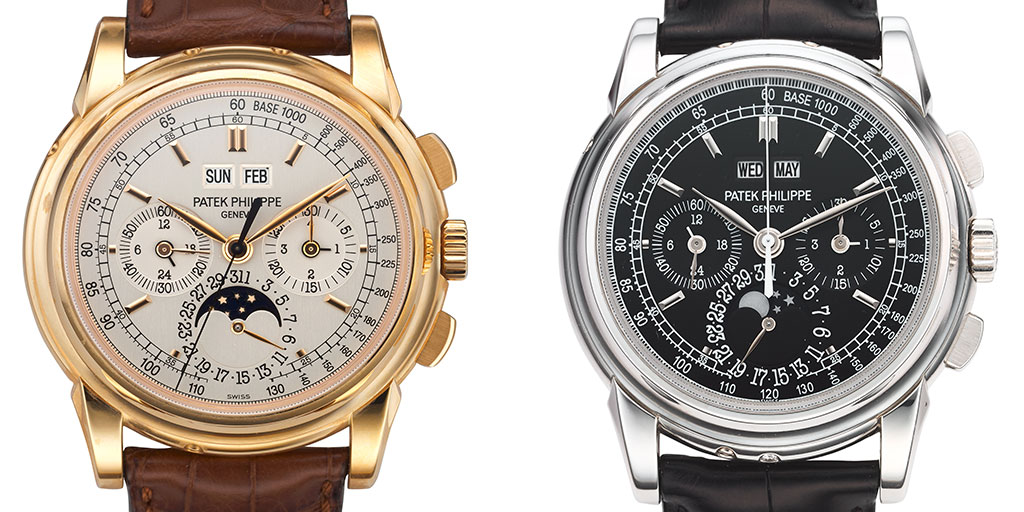
Dials were produced by Singer, a long-term supplier for Patek Philippe. They feature an interlaced ‘SJ’ engraving on the reverse, standing for Jean Singer, the founder of the dial manufacturer.
In regular production, each case metal was paired with only one dial type, making a total of 4 different references, each identified by the code “-001” in the reference: silver for the three gold colors and black for platinum. There were no facelifts or modifications, so no distinct ‘series’ exist, which makes collecting all the more straightforward.
The Moon Phases Disc
The ref. 5970 served as a transitional reference for moon phase production. The white and rose gold versions feature the mirror polished moon and stars and have a prominent black border identical to the ref. 3970. Starting with the yellow gold version, they have a more frosted finishing adding extra depth.
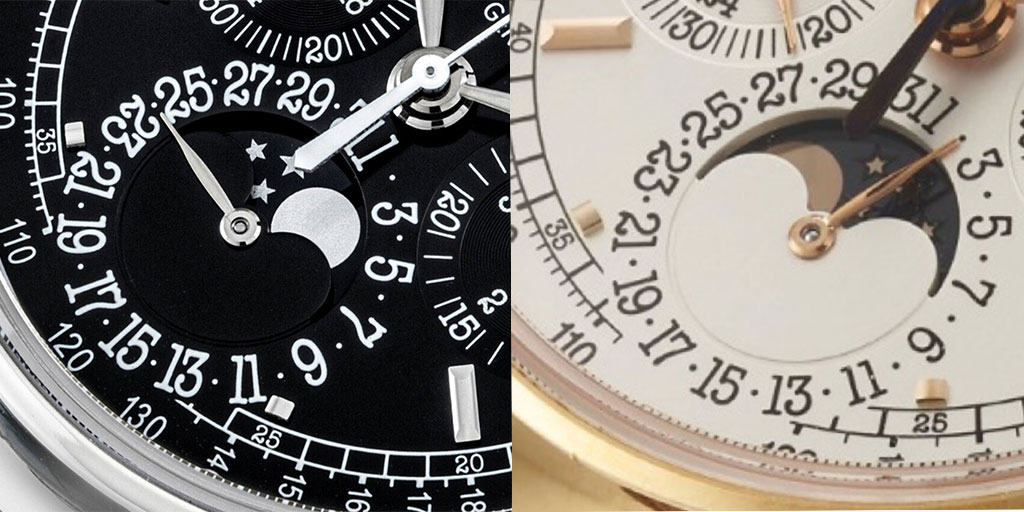
On both yellow and rose gold, the color of the moon is matching the case metal. On the white gold it’s blackened like the hands and indices. On the platinum it has a grey tone.
The Hands
Directly inspired by the ref. 1518 and ref. 2499 first series, and the two first series of the ref. 3970, the ref. 5970 features classical leaf-shaped (feuille) hour, minute and sub-counter main hands. The chronograph, day/night and leap year are baton-style hands. It is noteworthy that the length of the hands has been perfectly designed to reach the tip of the indications they are pointing towards once again enhancing legibility and reinforcing this feeling of harmony.
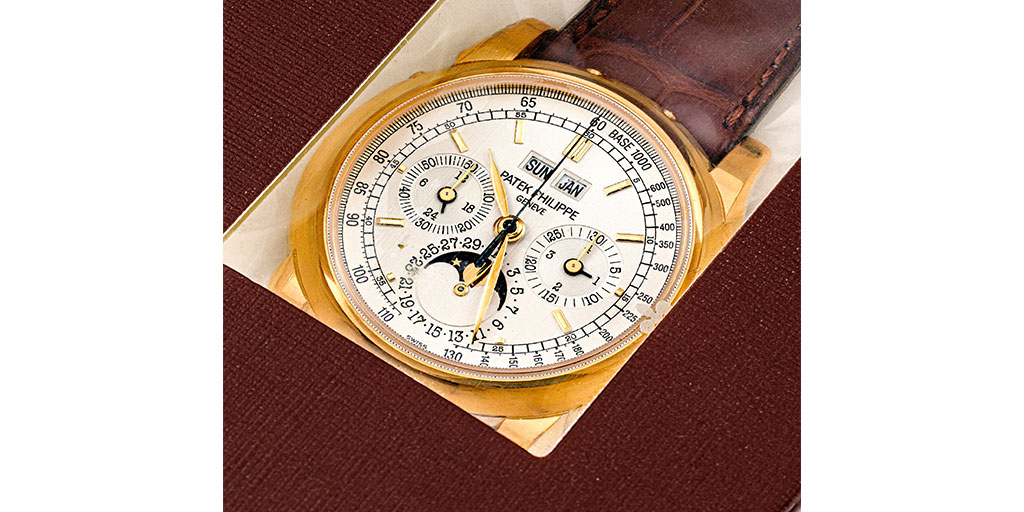
The color scheme used for the hands is as follows:
- Yellow and rose gold: matching gold feuille hands; blackened baton hands
- White gold: all hands blackened
- Platinum: white gold feuille hands; white baton hands
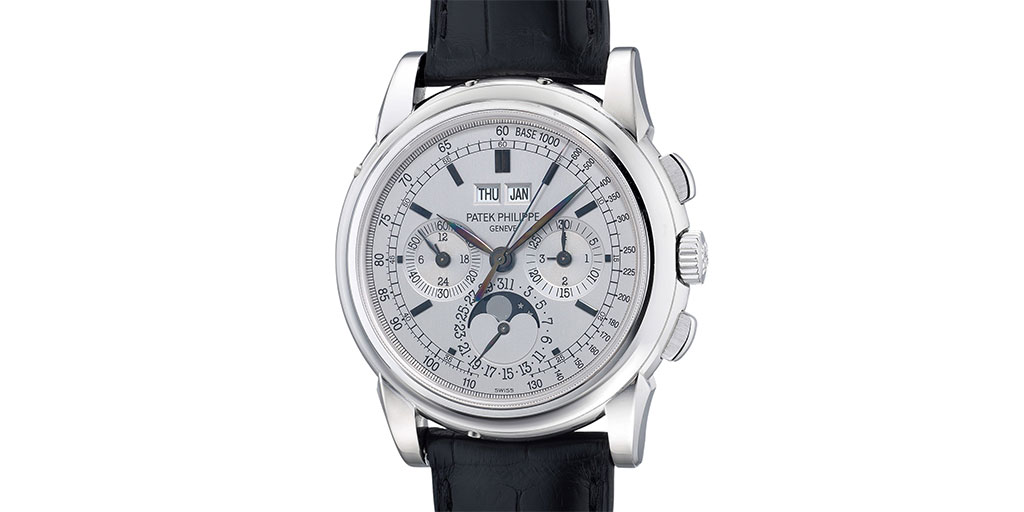
It is worth noting that oxidation on the blackened hands is extremely common, if not generalized. This happens on all three gold versions, as well as on the dial indexes of the white gold, even on double sealed watches that have never been opened. The hands tend to turn grey/blue/iridescent in a more or less homogeneous fashion.
The Movement
When turning over a ref. 5970, one is immediately struck by the beauty, the depth and the finishing of the 353-piece movement. The display case back opens up to the legendary caliber CH 27-70 Q, based on an extensively modified Nouvelle Lemania 2310 ébauche, known for its robustness, reliability, and long-term durability.
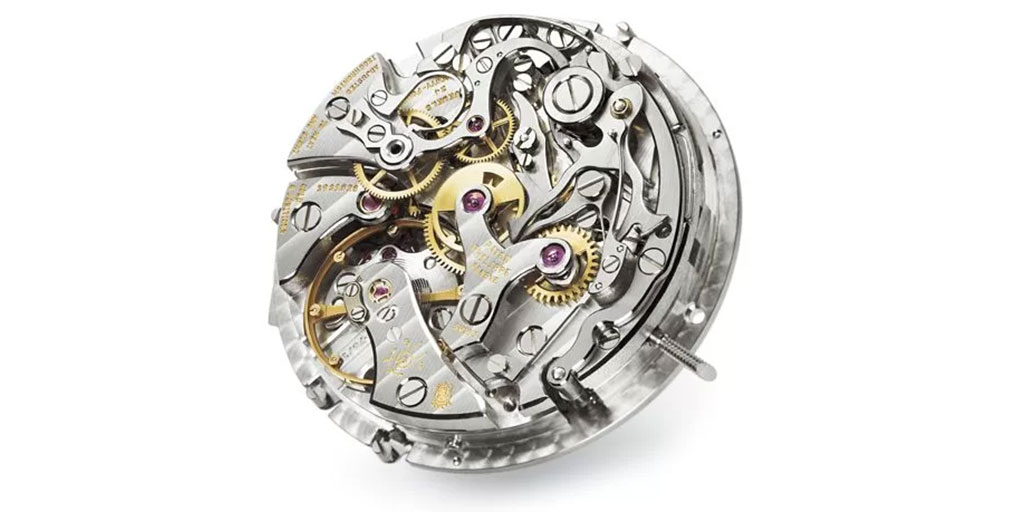
Initially released in 1942 by Lemania, it is one of the most celebrated Swiss chronograph movements. As was typical at the time, it was used by several manufacturers including Audemars Piguet, Vacheron Constantin, Omega, and others. Patek Philippe heavily modified and improved the base movement to meet its own standards adding a free-sprung Gyromax balance wheel, a completely redesigned chronograph lever and spring, a fully supported chronograph drive wheel, an escape wheel end-stone, a Geneva-style stud holder for the hairspring, and a cap for the column wheel, extending the power reserve to 60 hours. Finishing met the highest standards, leaving no component untreated and the movements were all awarded the Geneva Seal.
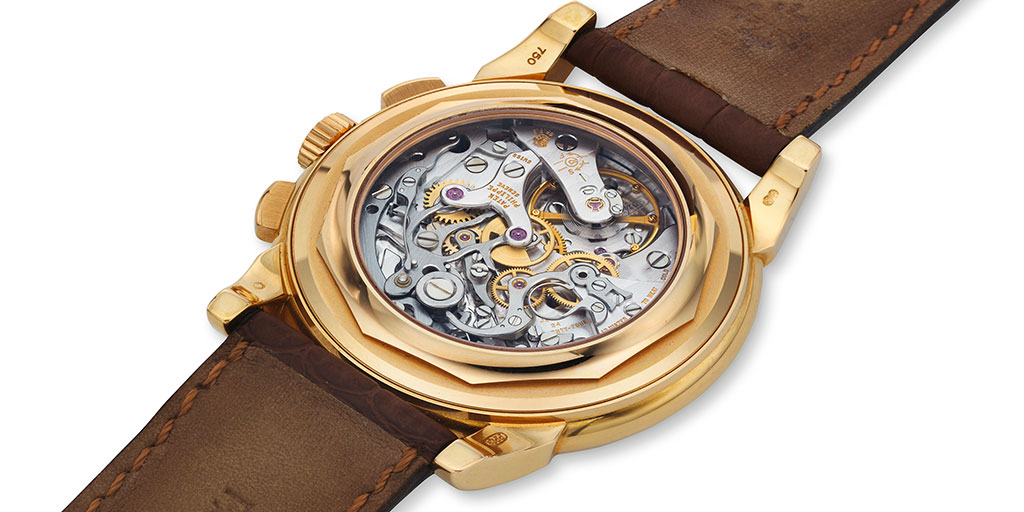
The perpetual calendar module was proprietary to Patek Philippe and was added on top of the chronograph caliber basis, hence the unique display of all functions, which no other brand has.
While Patek Philippe introduced its own quality seal in 2009, all ref. 5970 movements, even those released after that date, feature the Geneva Seal.
The ref. 5970 would be the last perpetual calendar chronograph to feature a movement that was not entirely made in-house by Patek Philippe.
The Strap and Buckle
The regular production watches were delivered with an alligator leather strap and a folding buckle in the same metal as the case.
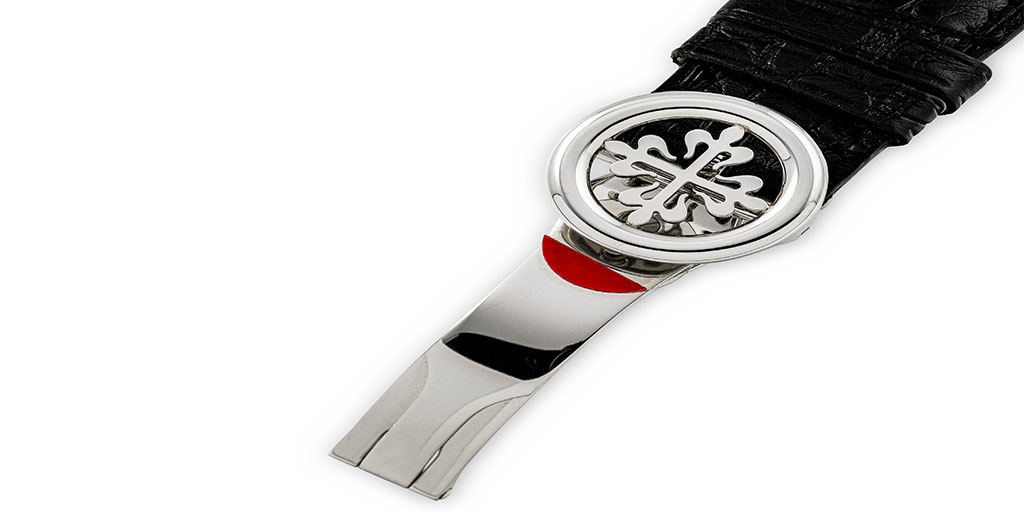
Metal bracelets were produced in rose gold, white gold, and platinum. These were fitted upon client request as special orders and carry reference numbers beginning with refs. 5970/1R (rose gold), 5970/1G (white gold) and 5970/1P (platinum). If the reference on the Certificate of Origin or Extract from the Archives starts with ref. 5970R (or G or P) but the watch has a metal bracelet, it means it’s a later addition, possibly by Patek Philippe itself – but the watch did not originally leave the factory with a metal bracelet.
The Full Set
The watches were delivered with:
- A wooden box and its outer carton
- A second solid case back with matching case numbers
- A setting pin
- A leather portfolio containing the instructions manual and three product leaflets
- A Certificate of Origin
The latter should not be confused with an Extract from the Archives, which is a document issued subsequently that details what was recorded in the archives. This extract can prove valuable when a dial change was made at a client’s request at the factory and was documented by Patek Philippe.
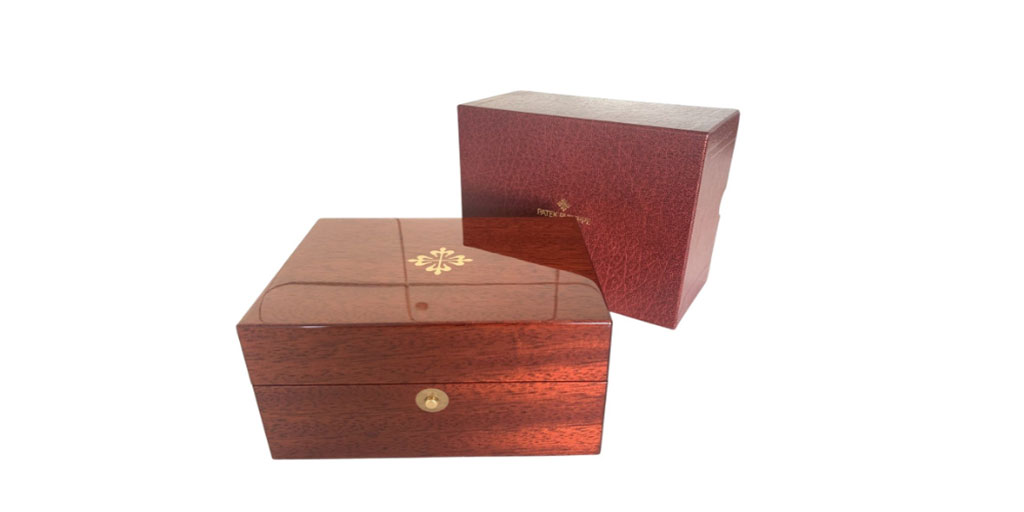
Around 2005, Patek Philippe transitioned from the red wood box to the brown lacquered box. Some early examples were delivered with the red wood box and retailers would give the new box as they cleared inventory of the previous generation.
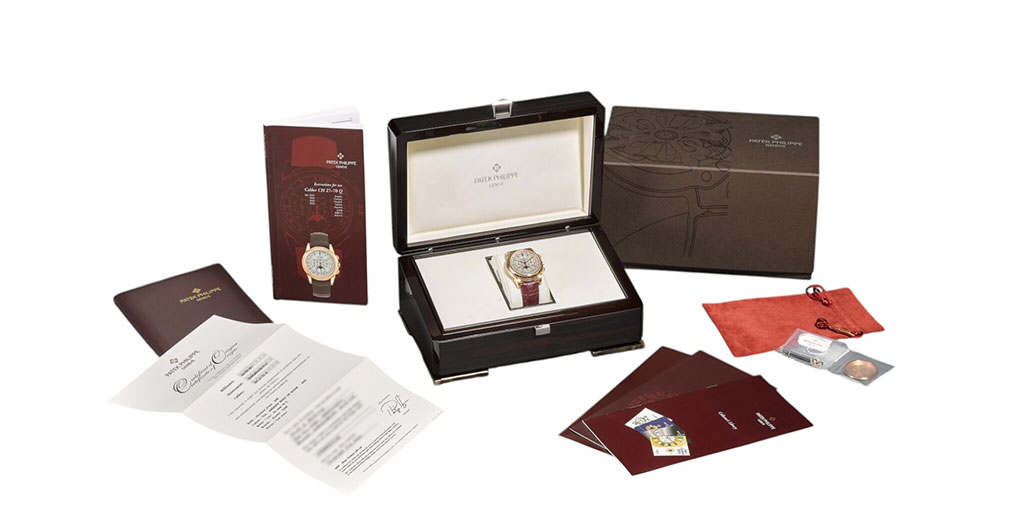
Since this model is relatively recent, collectors are encouraged to seek examples with complete accessory sets, both for historical completeness and to enhanced liquidity when reselling.
Collectability
The ref. 5970 has the shortest production run of any perpetual calendar chronograph, having been officially produced from 2004 to 2010. The first pieces were delivered beginning around November 2004 with regular production continuing through 2010 and even early 2011. A few ‘end-of-run’ editions in extremely small quantities were produced afterward.
The estimated production numbers are below. Please note these are just estimations and not actual production numbers since Patek Philippe has never released production numbers.
Total production: approximately 2,500-3,200 pieces
- Rose gold (2004-07): 800-1000 pieces
- White gold (2004-07): 800-1000 pieces
- Yellow gold (2008-09): 400-500 pieces
- Platinum (2009-10): 500-700 pieces
Each metal offers distinct appeal: rose gold for its warmth, white gold for its monochromatic elegance, yellow gold for its vintage character, and platinum for its distinctive black dial.
Among the four regular production models, through August 2025, the ref. 5970 has appeared 204 times at auction across Antiquorum, Christie’s, Phillips, Sotheby’s (see note 1):
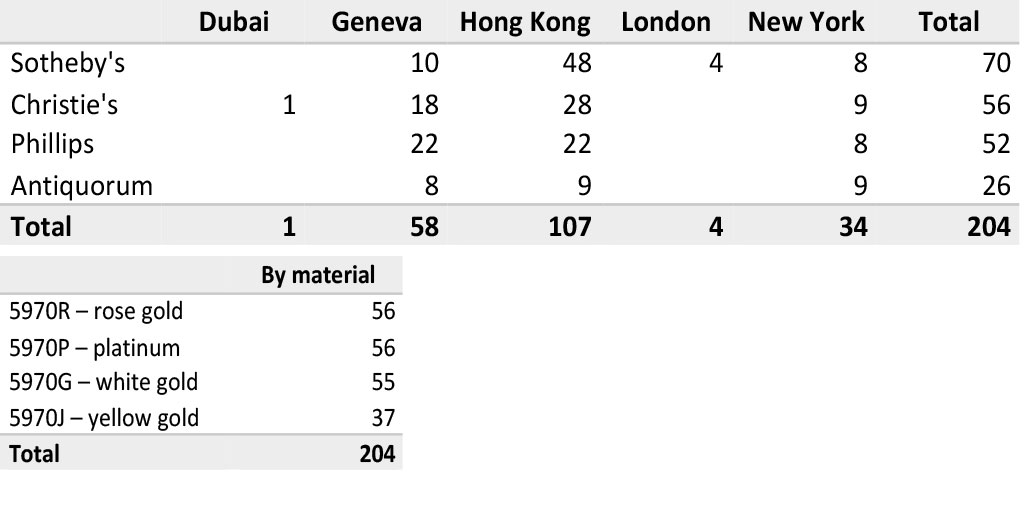
The following graph shows sales results evolution by metal (see note 1). Platinum is the most sought-after and commands a premium; the three gold versions are priced quite similarly, even yellow gold, which had the smallest production run.
For reference as of April 2009 in the USA, the MRSP of the 5970J was $128,000 and the 5970P $138,500.
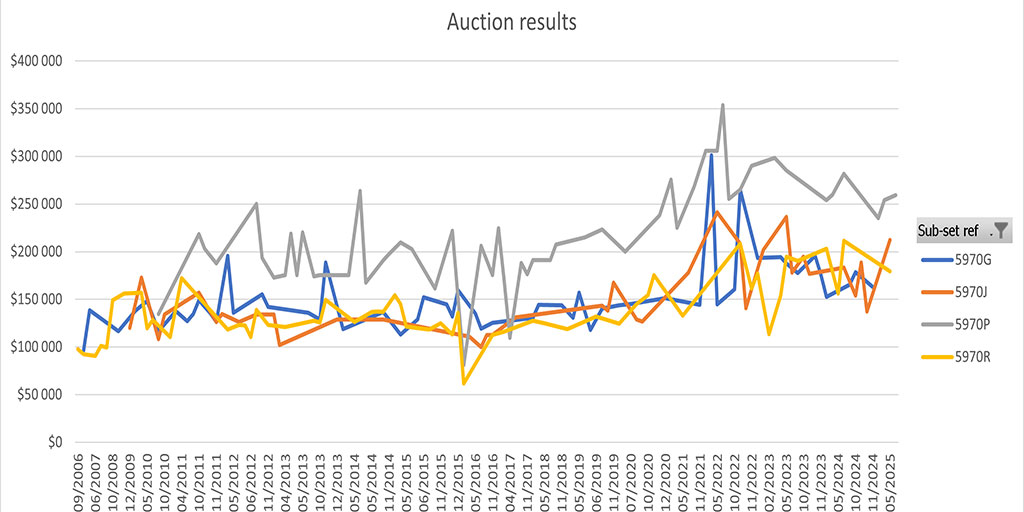
(1) All auction results include buyer’s premium and were converted to USD at the exchange rate of the day of the auction. To allow for comparability, the results only include regular production models (dial variation “-001”). Double sealed watches, Tiffany signed dials, bracelet watches and special editions/orders have been excluded.
Special Editions and Special Orders
Patek Philippe has a long tradition of creating ultra-limited special editions to commemorate particular events as well as special orders for its most important clients. These pieces hold deep personal significance for the collectors who commissioned them, who invest tremendous care and thought in designing these pieces with Patek Philippe to be both personally meaningful and respectful of the brand’s history.
The following lists publicly known pieces, but since Patek Philippe rarely issues official communications regarding special-order pieces and collectors often prefer to keep their commissions private, this list cannot be exhaustive. If you own other special-order pieces and would like them featured in this list, with or without a picture, please contact us by email, and we will be happy to update this guide.
Saatchi editions:
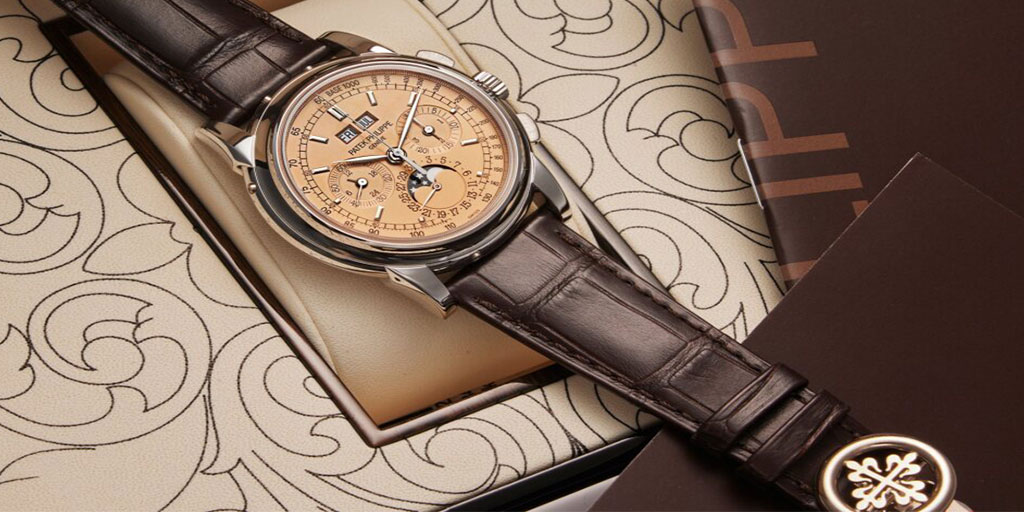
For the Grand Exhibition at the Saatchi Gallery in London in 2015, Patek Philippe released two special editions using remaining cases and movements (notably, these bear the Geneva Seal rather than the Patek Philippe Seal):
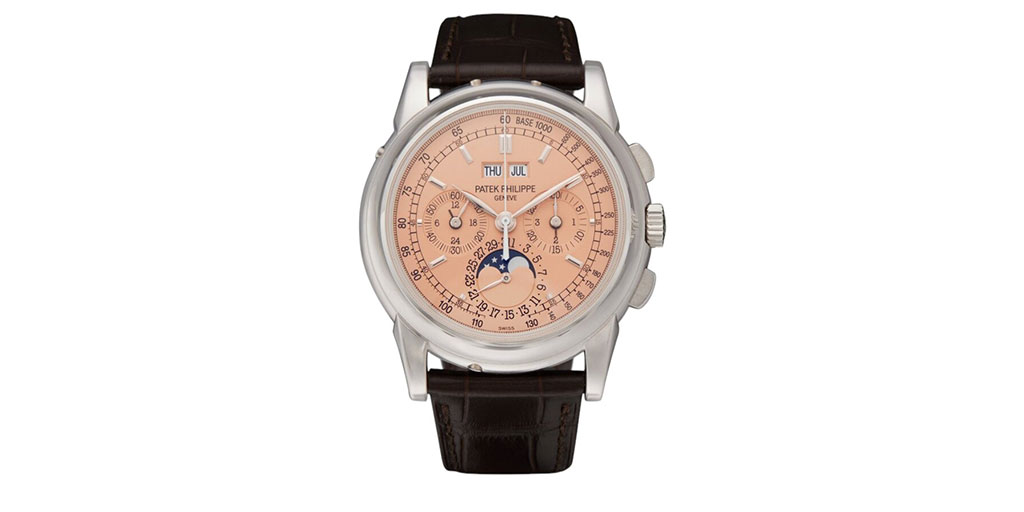
- Ref. 5970G-019: white gold, salmon dial (“rose 5N”) This holds the record as the most expensive 5970 sold at auction, reaching an impressive $1.32 million at Sotheby’s New York in November 2022.
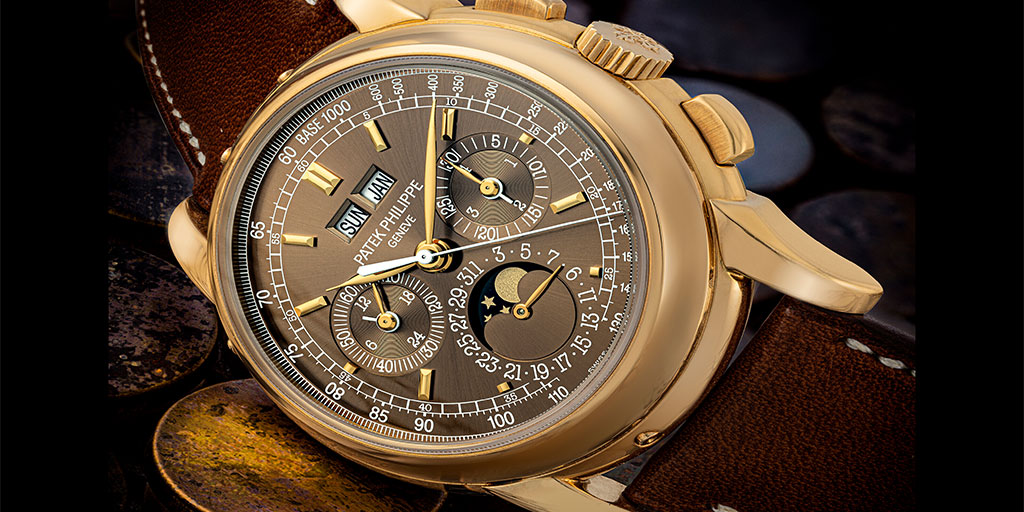
- Ref. 5970J-014: Yellow gold, brown dial (“brun”) This appeared only once at auction, reaching $602,000 at Christie’s Hong Kong in May 2023.
Charity edition:
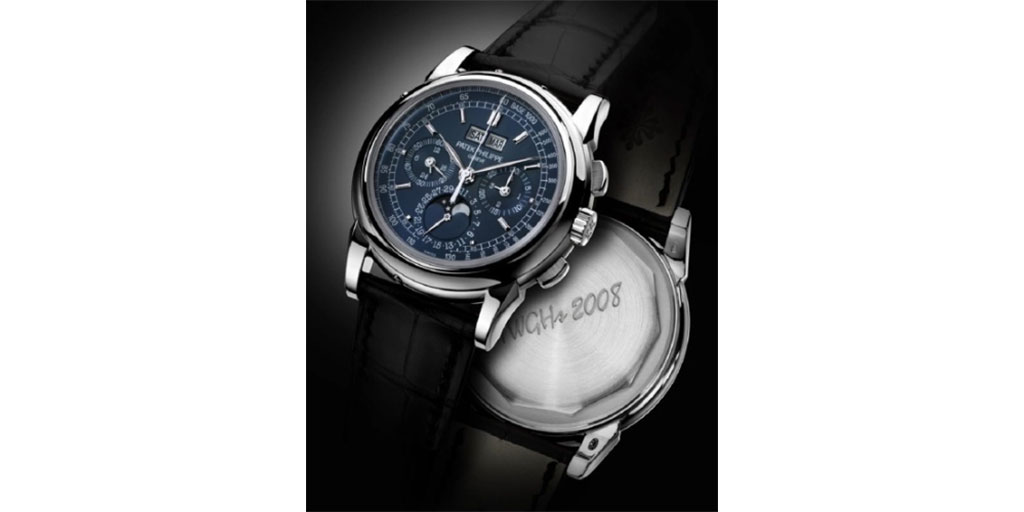
A unique platinum piece with a blue sunburst dial (ref. 5970P-010), engraved with ‘TWGHs 2008’ on the case back, was auctioned by Sotheby’s Hong Kong in March 2009 for $800,000. All proceeds went to the Tung Wah Group of Hospitals in Hong Kong. This was the most expensive ref. 5970 at the time and it held that record until 2021. It was also the very first platinum ref. 5970 before the presentation of the regular black dial version a few weeks later at Baselworld.
Special orders sets:
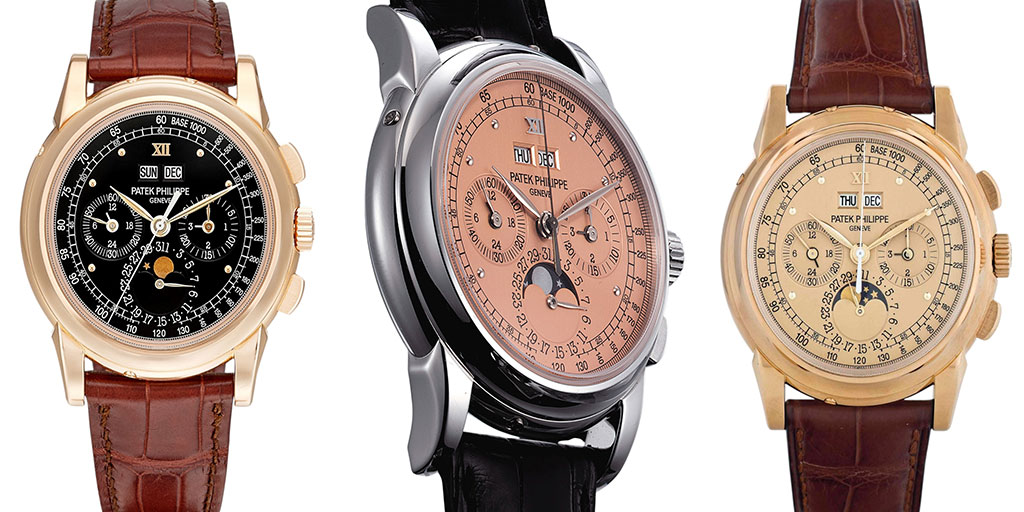
- A four-piece set featuring Roman numeral XII with dots at 1, 2, 4, 8, 10, and 11 o’clock positions: yellow gold/doré dial, rose gold/black dial, white gold/salmon dial and platinum/blue dial. Initially commissioned by @horology_ancienne in 2011, several of these sets were produced with individual pieces occasionally appearing at auction, though never a complete set.
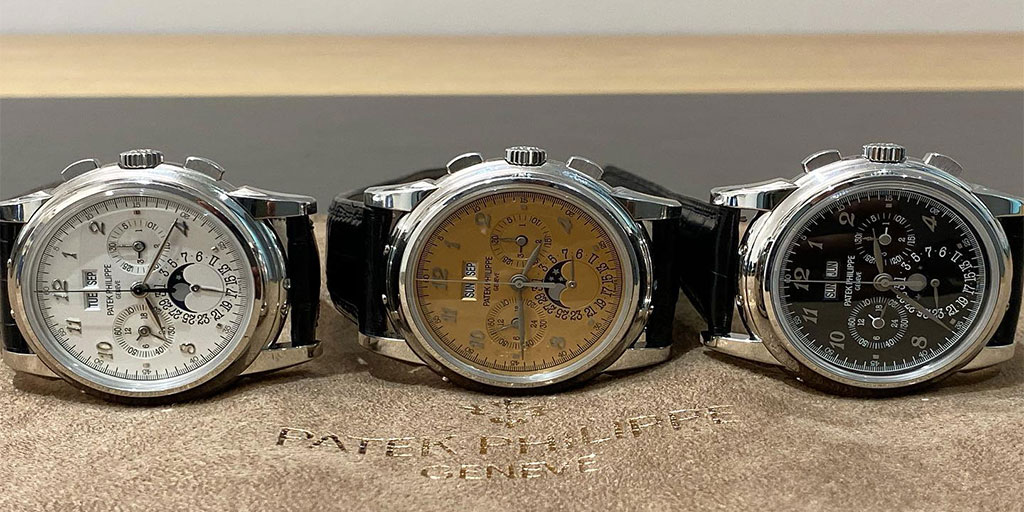
- A three-piece platinum set with full Breguet numerals and no tachymeter scale, featuring salmon, white, and black dials, commissioned by Eric Clapton and @horology_ancienne.
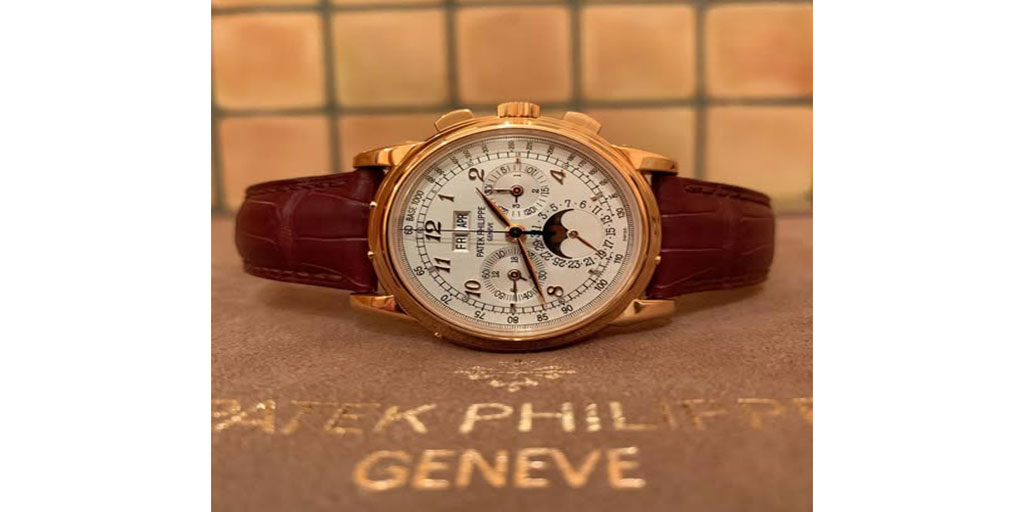
- A three-piece set with full Breguet numerals in rose, white and yellow gold commissioned by @horology_ancienne.
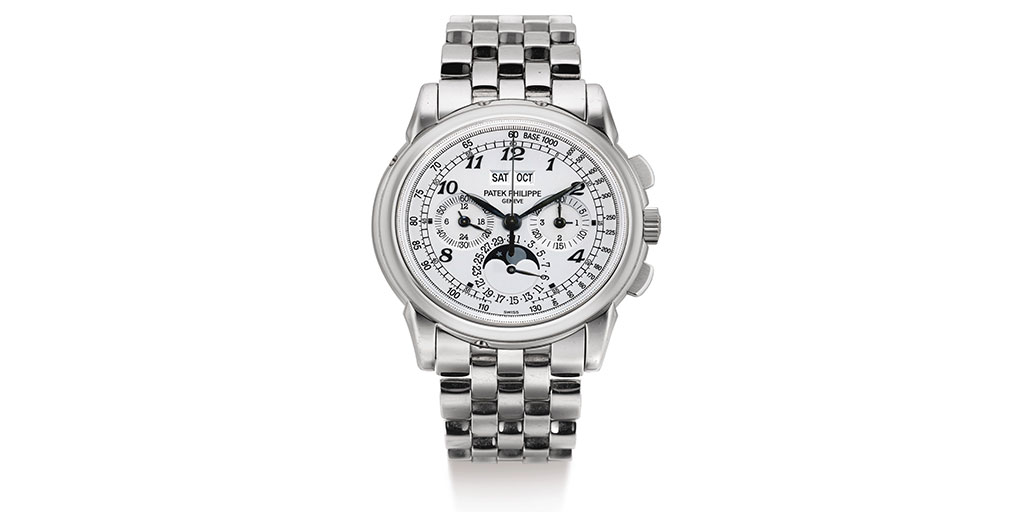
- A two-piece set with silver full Breguet numerals commissioned by Eric Clapton in rose gold with bracelet (Sotheby’s Geneva) and in white gold with bracelet (ref. 5970/1G-010, last sold at Sotheby’s Hong Kong).
Special Orders
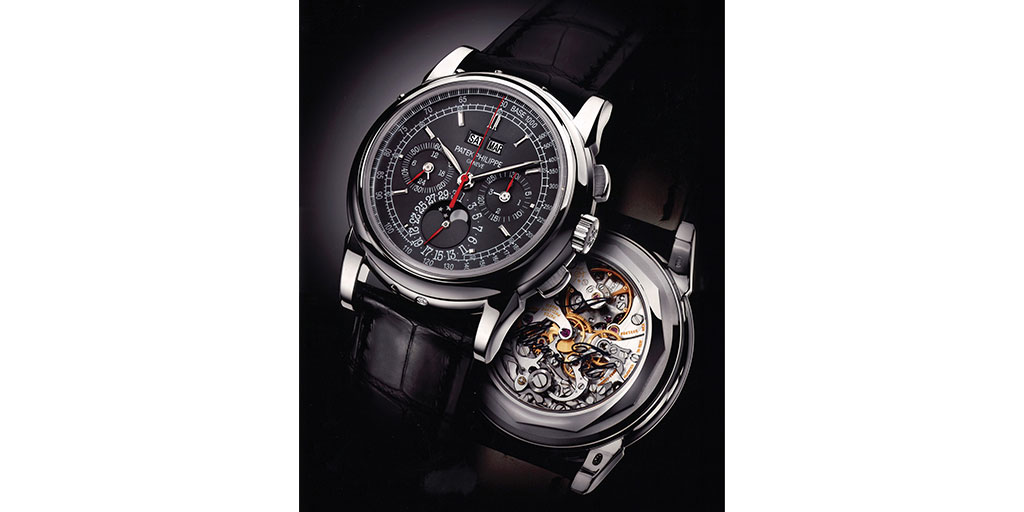
- Ref. 5970R: rose gold case, black dial with pulsation scale, all markings in rose gold– Forbes
- Ref. 5970R-019: rose gold, black dial, 2016 – Christie’s
- Ref. 5970/1R-011: rose gold, black dial, gold bracelet – Sotheby’s
- Ref. 5970G: white gold, silver dial with double pulsation scale – Forbes
- Ref. 5970J-012: yellow gold, black dial – K2 Luxury
- Ref. 5970P: platinum, grey dial, red hands – @vntgbug
- Ref. 5970P-013: platinum, grey dial, red hands, 2011 – Phillips
- Ref. 5970/1P-011: platinum, black dial, platinum bracelet – K2 Luxury
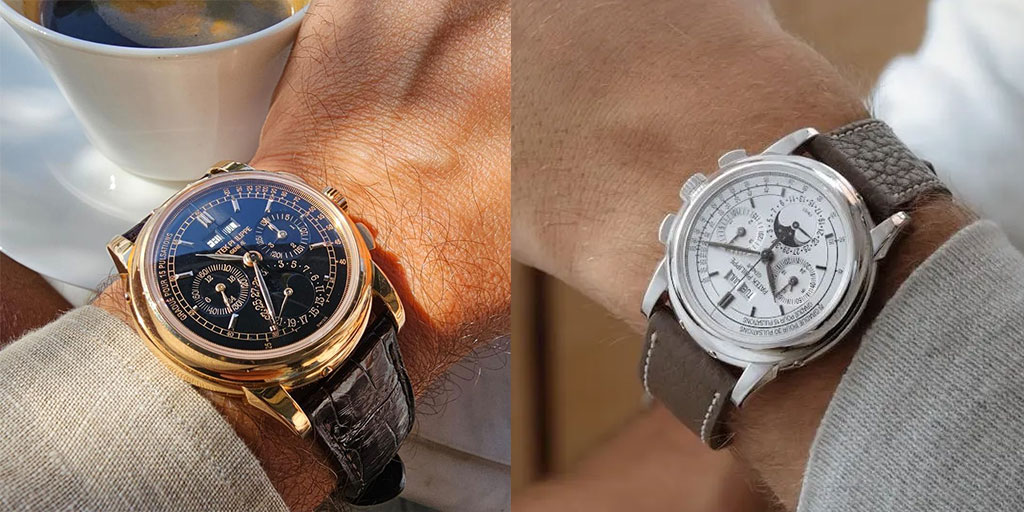
Tiffany’s double signed:
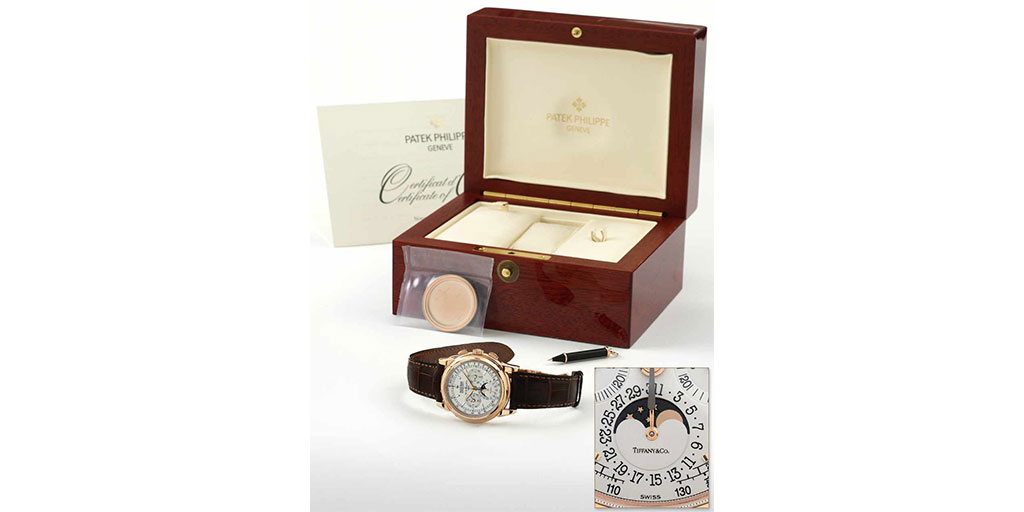
These are immediately recognizable by the small Tiffany & Co. signature stamped at 6 o’clock below the moon phase. Certificates show the same dial references as regular production models (-001) with ‘Tiffany & Co.’ printed on the certificate in either the authorized dealer field or at the bottom below the date. To date, only two yellow gold examples, two in rose gold, and one in platinum have appeared at major auction houses.
The Gem Set Ref. 5971P
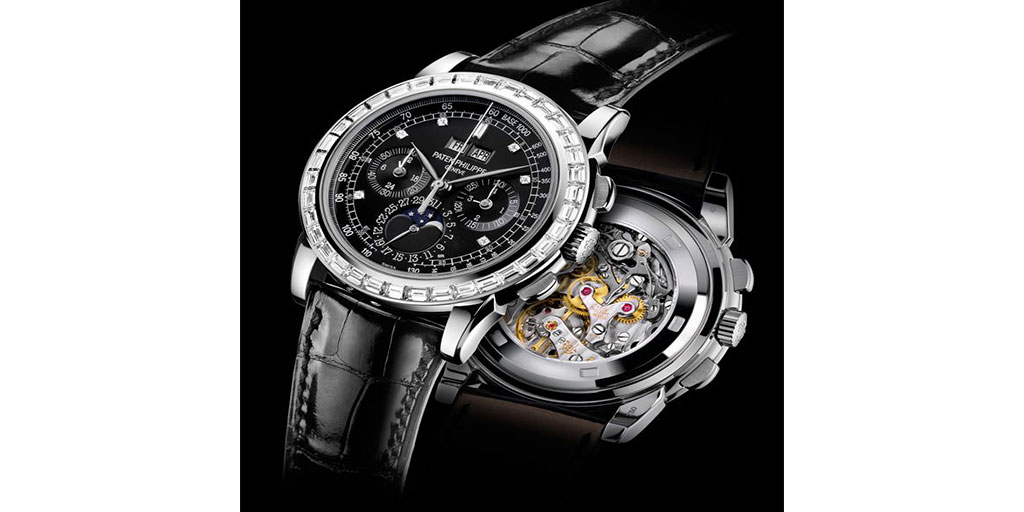
Adding even greater exclusivity, Patek Philippe released a spectacular diamond baguette-set version of the perpetual calendar chronograph, bearing ref. 5971P. This flagship model of the iconic complication was produced for only three years, from 2007 to 2010.
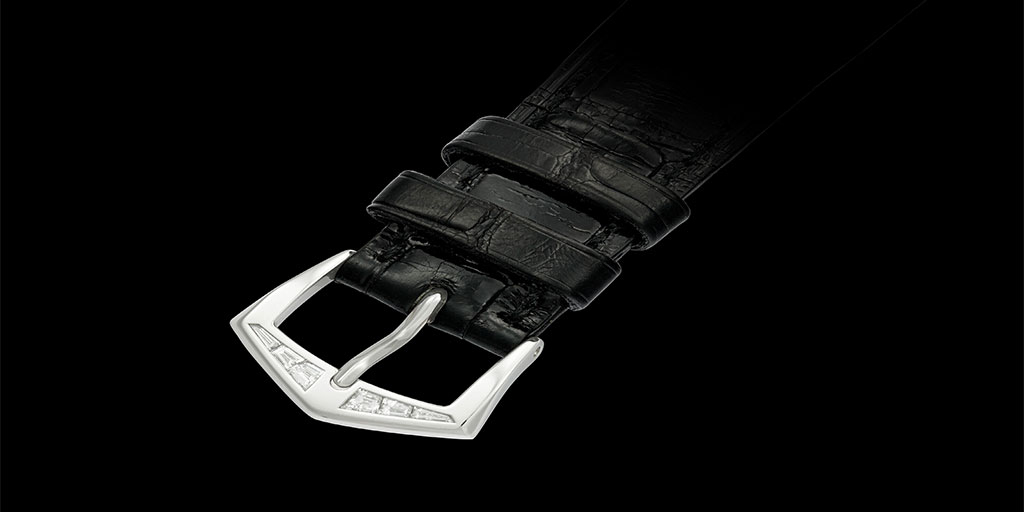
The bezel features 36 baguette-cut diamonds totaling approximately 4 carats. All regular production examples featured black dials. The dial maintains the same layout as gold versions but is adorned with a baguette diamond at 12 o’clock and round diamond indices at 1/2/4/8/10/11. Notably, the dial lacks the 120-tachymeter marking that was introduced with the ref. 5970P in 2008. Hands are executed in white gold, except for the day/night, leap year, and central chronograph hands, which are white. Watches were delivered with pin buckles also set with six custom baguette-cut diamonds (approximately 0.3 carats). No gem-set examples are known in other metals.
An estimated 100-200 regular production ref. 5971P pieces were manufactured during this three-year period.
To date, 46 examples of the ref. 5971P-001 have appeared at major auction houses. While in early years examples sold for significant premiums over non-gem-set versions, recent years have seen them selling for approximately 15% more than regular platinum versions, despite being significantly rarer and $80,000 more expensive at retail ($218,900 as of April 2009 in the USA).
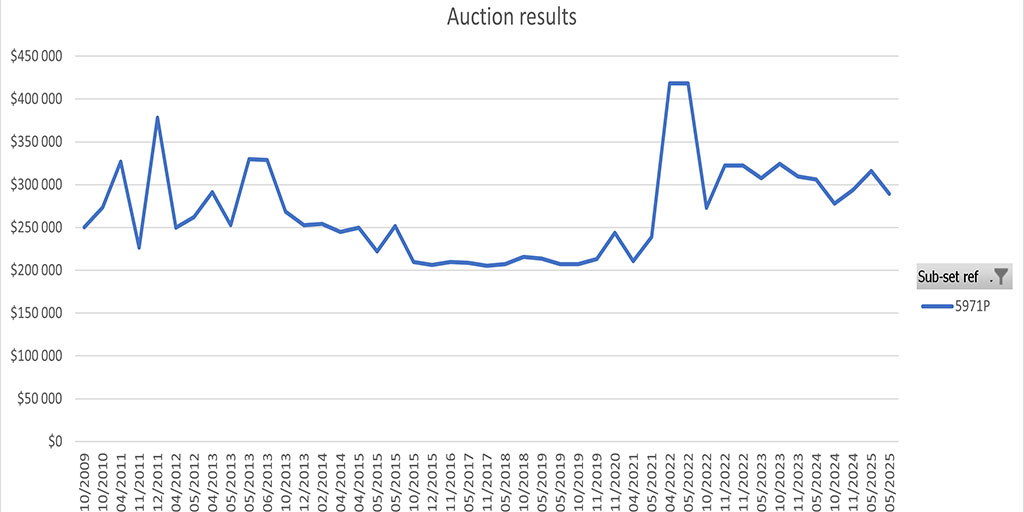
Beyond the diamond version, off-catalog ref. 5971P models were offered with sapphires (ref. 5971/11P), rubies (ref. 5971/12P), and emeralds (ref. 5971/13P). These pieces were produced in extremely limited quantities (likely fewer than 10 each) and were offered only to Patek Philippe’s most important clients. The type of setting is identical to the diamond version, with sapphires/rubies/emeralds on the bezel, dial and buckle.
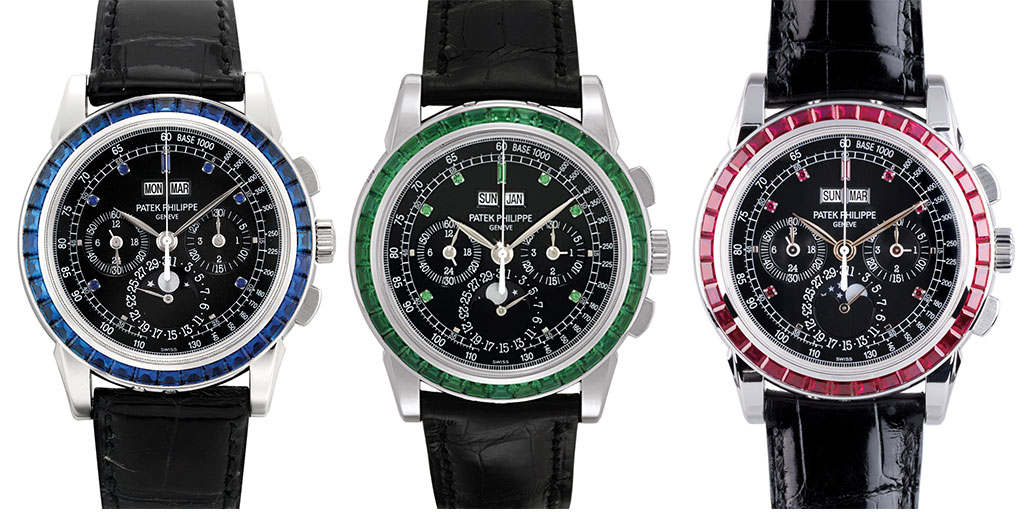
To date, only two emerald, two sapphire, and one ruby version have appeared at auction, with the ruby version achieving an impressive $1.155 million at Antiquorum Hong Kong in November 2022.
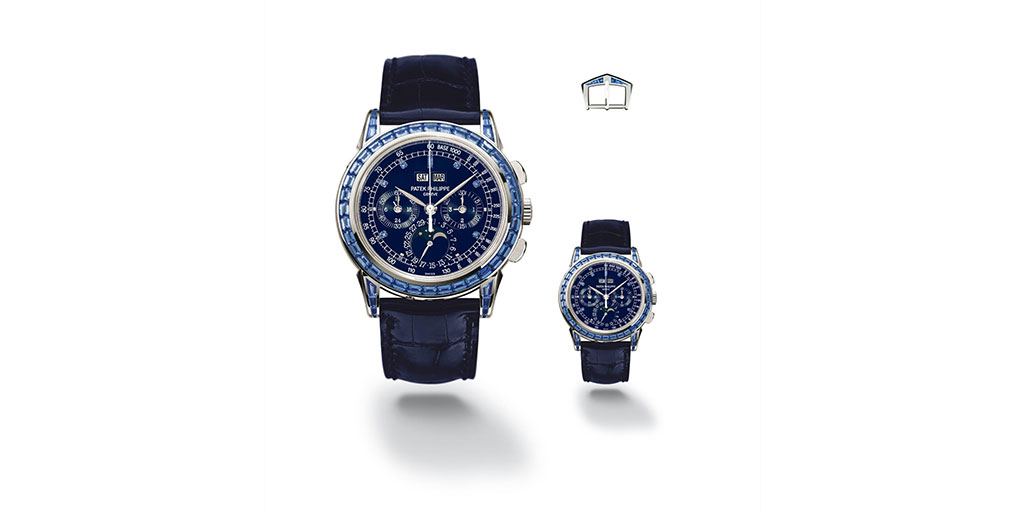
Two special orders ref. 5971P are known to date:
- Sapphire version with bezel and notably top of the lugs set and blue dial, commissioned by collector @ayyb55
- Diamond version with white dial: the watch was initially delivered with a black dial and changed to a white dial by Patek Philippe in 2011 as noted on the Extract from the Archives. It was last sold at Phillips.
Conclusion
The ref. 5970 occupies a unique position in Patek Philippe’s perpetual calendar chronograph lineage—representing both an end and a beginning. As the final reference to house a third-party movement base, it closes a chapter that began with the ref. 1518 in 1941. Yet its modern 40mm proportions, offering strong wrist presence and refined design language, established principles that continue to influence the brand today.
Several factors contribute to the ref. 5970’s significance among collectors. Its brief six-year production run makes it the shortest-produced perpetual calendar chronograph in the series. The thoughtful design updates—from the perfectly balanced dial to the distinctive lug shape—demonstrate how traditional complications can be successfully modernized without losing their essential character.
For collectors, the ref. 5970 represents an entry point into one of horology’s most important complication families, while offering the satisfaction of owning a reference that bridges Patek Philippe’s past with its contemporary direction. The availability of complete examples with original accessories, combined with the model’s relatively recent production, as well as the modern feel and strong wrist presence makes it particularly attractive. For any collector, owning a ref. 5970 will continue to represent a significant milestone.
September 2025
Collectability thanks Edouard Henn for his in-depth review of the ref. 5970. Edouard has been passionate about horology since his teenage years. He began his professional journey at Girard-Perregaux before transitioning to luxury retail across Europe and the Middle East. With a business education background, Edouard brings both product and collector’s perspective to his writing.

